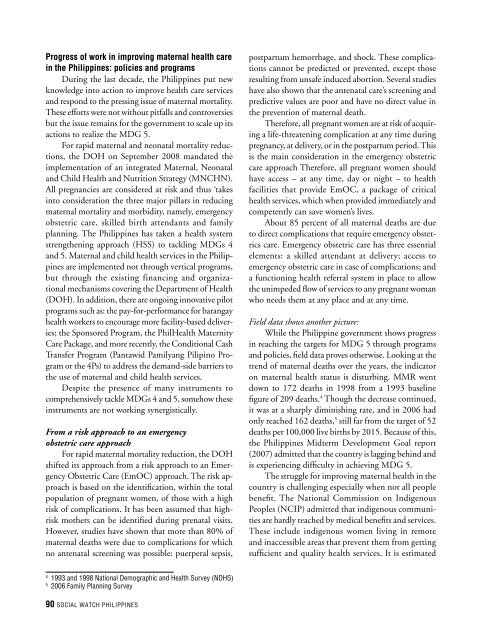Report - Social Watch Philippines
Report - Social Watch Philippines
Report - Social Watch Philippines
Create successful ePaper yourself
Turn your PDF publications into a flip-book with our unique Google optimized e-Paper software.
Progress of work in improving maternal health care<br />
in the <strong>Philippines</strong>: policies and programs<br />
During the last decade, the <strong>Philippines</strong> put new<br />
knowledge into action to improve health care services<br />
and respond to the pressing issue of maternal mortality.<br />
These efforts were not without pitfalls and controversies<br />
but the issue remains for the government to scale up its<br />
actions to realize the MDG 5.<br />
For rapid maternal and neonatal mortality reductions,<br />
the DOH on September 2008 mandated the<br />
implementation of an integrated Maternal, Neonatal<br />
and Child Health and Nutrition Strategy (MNCHN).<br />
All pregnancies are considered at risk and thus ‘takes<br />
into consideration the three major pillars in reducing<br />
maternal mortality and morbidity, namely, emergency<br />
obstetric care, skilled birth attendants and family<br />
planning. The <strong>Philippines</strong> has taken a health system<br />
strengthening approach (HSS) to tackling MDGs 4<br />
and 5. Maternal and child health services in the <strong>Philippines</strong><br />
are implemented not through vertical programs,<br />
but through the existing financing and organizational<br />
mechanisms covering the Department of Health<br />
(DOH). In addition, there are ongoing innovative pilot<br />
programs such as: the pay-for-performance for barangay<br />
health workers to encourage more facility-based deliveries;<br />
the Sponsored Program, the PhilHealth Maternity<br />
Care Package, and more recently, the Conditional Cash<br />
Transfer Program (Pantawid Pamilyang Pilipino Program<br />
or the 4Ps) to address the demand-side barriers to<br />
the use of maternal and child health services.<br />
Despite the presence of many instruments to<br />
comprehensively tackle MDGs 4 and 5, somehow these<br />
instruments are not working synergistically.<br />
From a risk approach to an emergency<br />
obstetric care approach<br />
For rapid maternal mortality reduction, the DOH<br />
shifted its approach from a risk approach to an Emergency<br />
Obstetric Care (EmOC) approach. The risk approach<br />
is based on the identifi cation, within the total<br />
population of pregnant women, of those with a high<br />
risk of complications. It has been assumed that highrisk<br />
mothers can be identifi ed during prenatal visits.<br />
However, studies have shown that more than 80% of<br />
maternal deaths were due to complications for which<br />
no antenatal screening was possible: puerperal sepsis,<br />
4 1993 and 1998 National Demographic and Health Survey (NDHS)<br />
5 2006 Family Planning Survey<br />
90 SOCIAL WATCH PHILIPPINES<br />
postpartum hemorrhage, and shock. These complications<br />
cannot be predicted or prevented, except those<br />
resulting from unsafe induced abortion. Several studies<br />
have also shown that the antenatal care’s screening and<br />
predictive values are poor and have no direct value in<br />
the prevention of maternal death.<br />
Therefore, all pregnant women are at risk of acquiring<br />
a life-threatening complication at any time during<br />
pregnancy, at delivery, or in the postpartum period. This<br />
is the main consideration in the emergency obstetric<br />
care approach Therefore, all pregnant women should<br />
have access – at any time, day or night – to health<br />
facilities that provide EmOC, a package of critical<br />
health services, which when provided immediately and<br />
competently can save women’s lives.<br />
About 85 percent of all maternal deaths are due<br />
to direct complications that require emergency obstetrics<br />
care. Emergency obstetric care has three essential<br />
elements: a skilled attendant at delivery; access to<br />
emergency obstetric care in case of complications; and<br />
a functioning health referral system in place to allow<br />
the unimpeded fl ow of services to any pregnant woman<br />
who needs them at any place and at any time.<br />
Field data shows another picture:<br />
While the Philippine government shows progress<br />
in reaching the targets for MDG 5 through programs<br />
and policies, fi eld data proves otherwise. Looking at the<br />
trend of maternal deaths over the years, the indicator<br />
on maternal health status is disturbing. MMR went<br />
down to 172 deaths in 1998 from a 1993 baseline<br />
fi gure of 209 deaths. 4 Though the decrease continued,<br />
it was at a sharply diminishing rate, and in 2006 had<br />
only reached 162 deaths, 5 still far from the target of 52<br />
deaths per 100,000 live births by 2015. Because of this,<br />
the <strong>Philippines</strong> Midterm Development Goal report<br />
(2007) admitted that the country is lagging behind and<br />
is experiencing diffi culty in achieving MDG 5.<br />
The struggle for improving maternal health in the<br />
country is challenging especially when not all people<br />
benefi t. The National Commission on Indigenous<br />
Peoples (NCIP) admitted that indigenous communities<br />
are hardly reached by medical benefi ts and services.<br />
These include indigenous women living in remote<br />
and inaccessible areas that prevent them from getting<br />
suffi cient and quality health services. It is estimated


